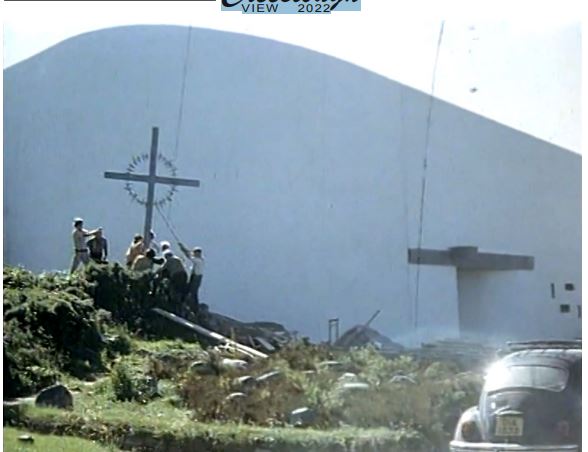By Eamonn McFadden
New film celebrates famed architects vision for St Michael’s Church in Creeslough
While having marked it’s Golden jubilee back in August, St Michael’s Church in Creeslough postponed its 50h anniversary celebrations until next year due to Covid restrictions, but a new film due to be released shortly tells the story of the building of the famed Liam McCormick design. It is hoped that as Covid restrictions ease that 2022 will see the Church finally get to celebrate the half century of one of Ireland’s most distinctive religious buildings. St Michael’s Church on Creeslough’s Main Street has fascinated and captivated passers-by for the last five decades with its distinctive outline and impressive design features.
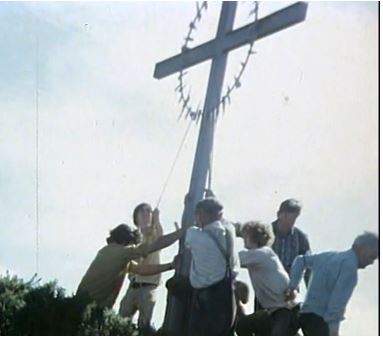
The new film, called “The Church & The Mountain” aims to tell the viewers about the history of how the building came to be. It features Dan McTeague, Letterkenny, Ken Bond, Portnablagh, Danny Langan from Creeslough, Margaret O’Brien from Ards, Fr Martin Doohan PP of Clondahorky Parish, and curate of St Michael’s Church, Fr John Joe Duffy. The film also features a wealth of archive footage filmed by the trusty 8mm cine camera of the late, great, Canon Tommy Doherty as well as other archive material from a range of local courses. Canon Doherty was passionate about filmmaking throughout his life and his work is a remarkable record of the people and places of yesteryear. At various intervals through the building process from the late Architect Liam McCormick, left, on site 1960’s, through to 1971, he would visit the site to capture each stage of the development work, as well as those who happen to pass by, or stop and view the work while he was there. This amazing footage shows, in colour, the whole process of the construction of the chapel, from green field site next to “Johnny’s Barn” right through to the official opening and consecration by Bishop Anthony McFeely. This footage was donated to the project by Canon Tommy’s nephew, well-known retired teacher Tommy Francis in Falcarragh, and the Raphoe Disocesen Archive. This footage perfectly captures not only the building process but the people who made this concept a reality and the many people that passed by as the building work took place. Canon Doherty was the local parish priest at the time and was based in Dunfanaghy. It was he who led the charge in terms of getting the project off the ground in the late 1960’s. The film delves into the unique process taken to help fund the chapel project at a time when rural Ireland was greatly impoverished. The new building was to replace the Church in Doe which was built by Father Bernard Rodan, a native of the parish, in 1784. It was later rebuilt by Father Peter Gallagher in 1830. The site was said to have been obtained by Fr Ennis McBride who died in 1794 and is buried in Clondahorkey graveyard. Another story is that the priest was a Franciscan, Fr Dominic Curden, who died in 1809 and is buried at Doe Castle. He asked the Landlord, William Wray of Ards, to grant a site for the chapel. Fr Dominic was a cousin of Father Rodan. Until then, people had to attend Mass at various Mass Rocks – Cashelmore, Creenera, Carnamaddy, Creeslough, Kilmacloo, Gortnalake and Sandhill. This Church of its time was built near to and in sight of the Mass Rock at Cashelmore. The remains of the church can still be seen at the site next to Doe graveyard, after it was dismantled down to just a few feet of Taken from the video are Danny Langan, Creeslough who plastered the church, Dan McTeague, Letterkenny who helped fundraise in the USA, Margaret O’Brien, Ards choir member for 69 years and Ken Bond of Bond Architects, Portnablagh.
The new St Michael’s Church was designed by renowned architect, Liam McCormick. Born in Derry in 1916 he had strong ties to Donegal throughout his life. Educated in Greencastle and St Columb’s College, Derry, Dr McCormick studied architecture at Liverpool University before he began his practice in Derry in 1947. That was when he and a fellow Liverpool graduate won the first major competition for a new church in Ennistymon, Co Clare. In 1948 McCormick and Frank Corr formed an architectural studio called Corr and McCormick. The studio continued to exist until 1968, when McCormick then formed McCormick Tracey Mullarkey. He continued to design churches until his retirement in 1982, after which he completed a number of private commissions. In the 1970s, McCormick’s architectural studio and offices were firebombed, leading to the total destruction of his professional records.
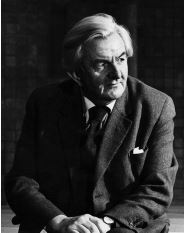
During his career, he designed some 27 new churches and church reconstructions throughout Ireland and England and locally these included St Peter’s Catholic Church in Milford as well as the iconic Burt Chapel, which is based on the nearby historic landmark of An Grianan Fort. This series of impressive churches is testimony to his position as the most accomplished Irish architect of his generation as well as the leading patron of modern Irish church art. McCormick also embraced a wide variety of building types including schools to social housing and private dwellings, including the home of his great friend and Nobel prize winning peace builder, John Hume in Inishowen. Other works included the iconic Met Éireann building in Glasnevin, Dublin. He received many awards, including the 1968 Triennial Gold Medal from the Royal Institute of Architects of Ireland (RIAI) for St Aengus Church in Co Donegal, and the Royal Institute of British Architect’s commendation for a church at Steelstown, Derry. Relocation When the decision was made to relocate the church in Creeslough from Doe to the village, McCormick won the design contract and got to work planning one of his most ambitious designs. In the film is Ken Bond of Bond Architects in Portnablagh, Dunfanaghy, a former colleague of McCormick having spent two years working with him in the early 1970’s. While Ken says he had no direct involvement with the design work of Creeslough chapel, he was working in McCormick’s office at the time in Derry and he helps give the viewer a unique insight into the influences that inspired the architect’s design choices for St Micheal’s. Ken, who runs his own architecture practice along with his son Phil, explains how his former colleague Liam had a range of international influences and these are highlighted in the film.
Fr Martin Doohan gives an insight to the tireless work of Canon Doherty in helping get the building project off the ground at a time when there was very little money in circulation in rural communities like Creeslough and Dunfanaghy. Fr Martin explains that Fr Tommy used his “God given talents” for humour, storytelling and filmmaking to go on a fundraising tour of the USA along with a music troupe made up of Dan McTeague, Jo McGlinchey and Maureen Hegarty. This innovative fundraising effort is well described by both Fr Martin and Dan McTeague. Dan is very well-known around the county and eloquently tells of what it was like to have travelled to the US where they performed in front of packed audiences made up of the immigrant Irish Diaspora in the several major cities they visited on the tour. Dan explains that the shows they took part in consisted of Fr Tommy performing his act of hilarious stories as well as showing some of his films from around Donegal that resonated well with the audience. Then Dan, Maureen and Jo would finish off the evening with a fine singing performance. The trip was hugely successful and helped significantly towards the cost of the new church.
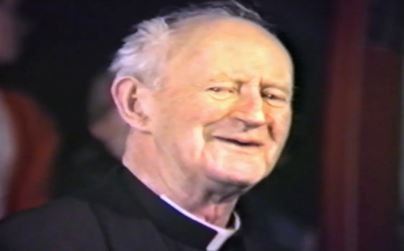
Well-known Creeslough man, Danny Langan, was one of several local men who worked on the building of the chapel. He, along with Seamus Dorrian and Sean Doherty of Fanad, plastered the church inside and out. Danny’s interviews give a great account of the scale of the project and the work that went on to help the architect realise his complex design. He explains that while John Hegarty from Buncrana was the main contractor, there were a few locals who worked on the project. Other local men who worked on it included Donal Gallagher, Vincent Grier, Ben McFadden and the late Don Johnston among others. New era Long serving choir member, Margaret O’Brien from Ards also features and gives a great insight to the old Doe church, where she first joined the choir as a young girl. She has been a stalwart member of the choir ever since and recalled what it was like to sing and attend the old Doe Church, a much more traditional church building than what was being built in Creeslough in 1971. She also outlined what the occasion was like on August 15th, 1971, when the last mass took place in Doe, just before the crowds started to gather in Creeslough for the consecration of the new building by Bishop Anthony McFeely. Again, this is wonderfully captured by the movie camera of Canon Tommy – albeit he clearly brought in another camera operator for the day as he was one of the main celebrant of the service, along with Bishop McFeely and Fr John Silke, who gave the homily on the day having returned from the US for the occasion where he was working as professor of History at Manhattan University. The new film was written and Directed by Eamonn McFadden from Creeslough, who runs Glass Mountain Digital Media and was funded by Creative Ireland in conjunction with Donegal County Council and the The Department of Tourism, Culture, Arts, Gaeltacht, Sport and Media. Eamonn explained that there was a mix of good fortune and good timing in how the film came to fruition.
He explained: “We had worked on a number of other local history project in the past, including ‘Glass Mountain: The Story of Muckish Sand’, ‘High Cross’ and our recent tribute film to computing pioneer, Kay McNulty from Feymore, but we hadn’t done anything on a bigger scale for a while. The opportunity to do something on St Michael’s church was always a story just waiting to be told, especially on the year of its 50th anniversary, but it wasn’t until we were shown the archive footage Canon Doherty filmed of the building work that we really knew we had the making of good film as we knew there were people locally who would have a great insight to the time, either directly or indirectly, and this was something we thought we could develop. Then came an opportunity of some funding to help the project from Creative Ireland, so this allowed us to get the film made over the summer months.”
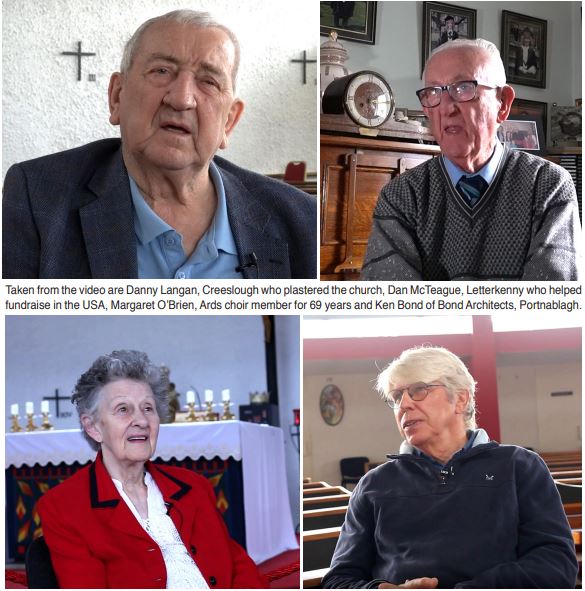
He added: “We felt it was a good thing to do this year as the church was unable to host the type of anniversary event they would have liked to to mark this milestone. 50 years is a long time but many in the community have memories of the old Doe church, the building of the new church and the excitement of the official opening day and it is great to get that story from those who were there. We are very grateful to those who took part in the film as well as the many others who helped us in terms of research, with archive material and stories. Unfortunately one of the things we couldn’t do is feature all the people we would have liked to due to time and budget restrictions, but we hope that more stories will emerge from this special time as the events of next year approach. “I was always fascinated with the church from a young age as I had never seen anything like it anywhere else. The level of design and craftsmanship that has gone into it has really stood the test of time and to have a McCormick church in Creeslough is something everyone should be proud of. Indeed, Fr John Joe Duffy explains in the film who so many people travel from all corners of Ireland overseas just to observe this original piece of design and architecture”
The producers say they would sincerely like to thank all who helped in the project and hope to be in a position to host a number of local screenings in the locality before the film is uploaded on YouTube to share with everyone. Liam McCormick (above) passed away in 1996, aged 80. The Heritage Council has described him as “one of the most important church architects of his generation”, while Dr Edward Daly, retired bishop of Derry, said his living memorial will be “his churches, and the sound of the sea which he loved ‘’.
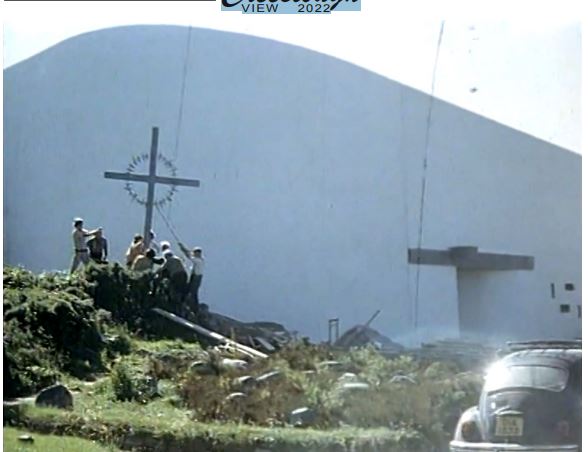
The filmmakers say they are very happy to showcase his work, as well as the work of all those who fundraised and built the chapel, and particularly the vision of the late Canon Doherty – a much loved and missed figure who has brought to life this remarkable time in our recent history. The film was shown locally and is now available to view on YouTube. For more information visit www.glassmountain.ie

